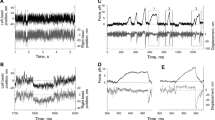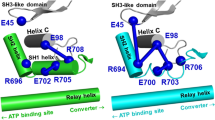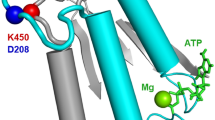Abstract—
It is known that the regulation of muscle contraction is carried out by tropomyosin and calcium-sensitive protein troponin, which form thin filament with the F-actin. The noncanonical glycine residue at position 126 of the central part of the skeletal alpha-tropomyosin destabilizes the structure of this protein. The substitution of glycine residue by arginine residue stabilizes the central region of tropomyosin, displaces tropomyosin to the open position and activates the switching actin monomers on during the ATP hydrolysis cycle. To investigate how Gly126Arg substitution affects the interaction of the myosin head with F-actin in the ATP hydrolysis cycle, the myosin subfragment-1 (S1) was modified with a 1,5-IAEDANS fluorescent probe and AEDANS-S1 was incorporated into the ghost muscle fiber. Multistage changes in the mobility and spatial organization of the myosin head during simulation of different stages of the ATP hydrolysis cycle were studied by polarization fluorescence microscopy. It was shown that, in the regulated thin filaments of the ghost muscle fiber at high concentrations of Ca2+, Gly126Arg substitution significantly increases the number of myosin heads strongly associated with F-actin when simulating strong binding of myosin to actin, but reduces the number of such heads when imitating weak binding of myosin. Such changes in the behavior of myosin in the ATP hydrolysis cycle indicate an increase in the efficiency of myosin cross-bridges. A significant increase in the relative amount of myosin strongly bound to actin was also observed at low Са2+ concentrations. This indicates an increase in Са2+-sensitivity of a thin filament initiated by Gly126Arg substitution. The obtained data suggest that the stabilization effects of the central part of tropomyosin by Gly126Arg substitution are realized through the abnormal behavior of tropomyosin and troponin, which leads to a change in the nature of the interaction of myosin with actin and tropomyosin in the ATP hydrolysis cycle.

Similar content being viewed by others
REFERENCES
Borejdo, J. and Putnam, S., Polarization of fluorescence from single skinned glycerinated rabbit psoas fibres in rigor and relaxation, Biochim. Biophys. Acta, 1977, vol. 459, pp. 578–595.
Borovikov, Y.S., Karpicheva, O.E., Avrova, S.V., and Redwood, C.S., Modulation of the effects of tropomyosin on actin and myosin conformational changes by troponin and Ca2+, Biochim. Biophys. Acta, 2009, vol. 1794, pp. 985–994.
Borovikov, Y.S., Rysev, N.A., Avrova, S.V., Karpicheva, O.E., Borys, D., and Moraczewska, J., Molecular mechanisms of deregulation of the thin filament associated with the R167H and K168E substitutions in tropomyosin Tpm 1.1, Arch. Biochem. Biophys, 2017, vol. 614, pp. 28–40.
Brown, J.H., Cohen, C., and Parry, D.A., Heptad breaks in alpha-helical coiled coils: stutters and stammers, Proteins, 1996, vol. 26, pp. 134–145.
Chalovich, J.M., Disease causing mutations of troponin alter regulated actin state distributions, J. Muscle Res. Cell Motil., 2012, vol. 33, pp. 493–499.
Fujita, H., Lu, X., Suzuki, M., Ishiwata, S., and Kawai, M., The effect of tropomyosin on force and elementary steps of the cross-bridge cycle in reconstituted bovine myocardium, J. Physiol., 2004, vol. 556, pp. 637–649.
Geeves, M.A., The dynamics of actin and myosin association and the crossbridge model of muscle contraction, Biochem. J., 1991, vol. 274, pp. 1–14.
Goody, R.S. and Hofmann, W., Stereochemical aspects of the interaction of myosin and actomyosin with nucleotides, J. Muscle Res. Cell Motil., 1980, vol. 1, pp. 101–115.
Gordon, A.M., Homsher, E., and Regnier, M., Regulation of contraction in striated muscle, Physiol. Rev., 2000, vol. 80, pp. 853–924.
Hitchcock-Degregori, S.E., Tropomyosin: function follows structure, Adv. Exp. Med. Biol., 2008, vol. 644, pp. 60–72.
Karpicheva, O.E., Sirenko, V.V., Rysev, N.A., Simonyan, A.O., Borys, D., Moraczewska, J., and Borovikov, Y.S., Deviations in conformational rearrangements of thin filaments and myosin caused by the Ala155Thr substitution in hydrophobic core of tropomyosin, Biochim. Biophys. Acta, 2017, vol. 1865, pp. 1790–1799.
Lehman, W., Switching muscles on and off in steps: the McKillop–Geeves three-state model of muscle regulation, Biophys. J., 2017, vol. 112, pp. 2459–2466.
Lehman, W., Craig, R., and Vibert, P., Ca(2+)-induced tropomyosin movement in limulus thin filaments revealed by three-dimensional reconstruction, Nature, 1994, vol. 368, pp. 65–67.
Lehman, W., Orzechowski, M., Li, X.E., Fischer, S., and Raunser, S., Gestalt-binding of tropomyosin on actin during thin filament activation, J. Muscle Res. Cell Motil., 2013, vol. 34, pp. 155–163.
Mason, J.M. and Arndt, K.M., Coiled coil domains: stability, specificity, and biological implications, ChemBioChem, 2004, vol. 5, pp. 170–176.
Margossian, S. and Lowey, S., Preparation of myosin and its subfragments from rabbit skeletal muscle, Methods Enzymol., 1982, vol. 85, pp. 55–71.
Matyushenko, A.M., Artemova, N.V., Shchepkin, D.V., Kopylova, G.V., Nabiev, S.R., Nikitina, L.V., Levitsky, D.I., and Bershitsky, S.Y., The interchain disulfide cross-linking of tropomyosin alters its regulatoryproperties and interaction with actin filament, Biochem. Biophys. Res. Commun., 2017, vol. 482, pp. 305–309.
McKillop, D.F. and Geeves, M.A., Regulation of the interaction between actin and myosin S1: evidence for three states of the thin filament, Biophys. J., 1993, vol. 65, pp. 693–701.
Monteiro, P.B., Lataro, R.C., Ferro, J.A., and Reinach, C., Functional alpha-tropomyosin produced in Escherichia coli, J. Biol. Chem., 1994, vol. 269, pp. 10461–10466.
Nevzorov, I.A., Nikolaeva, O.P., Kainov, Y.A., Redwood, C.S., and Levitsky, D.I., J. Biol. Chem., 2011, vol. 286, pp. 15766–15772.
Okamoto, Y. and Sekine, T., A streamlined method of subfragment one preparation from myosin, J. Biol. Chem., 1985, vol. 98, pp. 1143–1145.
Perry, S.V., Vertebrate tropomyosin: distribution,properties and function, J. Muscle Res. Cell Motil., 2001, vol. 22, pp. 5–49.
Potter, J.D., Preparation of troponin and its subunits, Methods Enzymol., 1982, vol. 85, pp. 241–263.
Robinson, P., Lipscomb, S., Preston, L.C., Altin, E., Watkins, H., Ashley, C.C., and Redwood, C.S., Mutations in fast skeletal troponin I, troponin T, and beta-tropomyosin that cause distal arthrogryposis all increase contractile function, FASEB J., 2007, vol. 21, pp. 896–905.
Roopnarine, O. and Thomas, D.D., Orientation of intermediate nucleotide states of indane dione spin-labeled myosin heads in muscle fibers, Biophys. J., 1996, vol. 70, pp. 2795–2806.
Rysev, N.A., Nevzorov, I.A., Avrova, S.V., Karpicheva, O.E., Redwood, C.S., Levitsky, D.I., and Borovikov, Y.S., Gly126Arg substitution causes anomalous behaviour of α‑skeletal and β-smooth tropomyosins during the ATPase cycle, Arch. Biochem. Biophys., 2014, vol. 543, pp. 57–66.
Shchepkin, D.V., Matyushenko, A.M., Kopylova, G.V., Artemova, N.V., Bershitsky, S.Y., Tsaturyan, A.K., and Levitsky, D.I., Stabilizationof the central part of tropomyosin molecule altersthe Ca2+-sensitivity of actin–myosin interaction, Acta Naturae, 2013, vol. 5, pp. 126–129.
Shchepkin, D.V., Nabiev, S.R., Kopylova, G.V., Matyushenko, A.M., Levitsky, D.I., Bershitsky, S.Y., and Tsaturyan, A.K., Cooperativity of myosininteraction with thin filaments is enhanced bystabilizing substitutions in tropomyosin, J. Muscle Res. Cell Motil., 2017, vol. 38, pp. 183–191.
Tregear, R.T. and Mendelson, R.A., Polarization from a helix of fluorophores and its relation to that obtained from muscle, Biophys. J., 1975, vol. 15, pp. 455–467.
ACKNOWLEDGMENTS
The study was supported by the Russian Science Foundation, grant 17-14-01224. The obtaining of recombinant wild-type tropomyosin and Gly126Arg-mutant form was carried out with the financial support of an FEBS Collaboration Scholarship.
Author information
Authors and Affiliations
Corresponding author
Ethics declarations
Сonflict of interests. The authors declare that they have no conflict of interest.
Statement on the welfare of animals. All applicable international, national, and institutional guidelines for the care and use of animals were followed.
Additional information
Translated by V. Mittova
Abbreviations: ATP—adenosine triphosphate, ADP—adenosine diphosphate, ATPγS—adenosine-5'-[γ-thio]-trisphosphate, F‑actin—fibrillary actin, 1,5-IAEDANS-N-iodoacetyl-N'-(5-sulfo-1-naphthyl)ethylene diamine, S1–myosin subfragment-1.
Rights and permissions
About this article
Cite this article
Rysev, N.A., Nevzorov, I.A., Karpicheva, O.E. et al. The Effect of Gly126Arg Substitution in Alpha-Tropomyosin on Interaction of Myosin with Actin in the ATP Hydrolysis Cycle. Cell Tiss. Biol. 12, 510–516 (2018). https://doi.org/10.1134/S1990519X1806010X
Received:
Published:
Issue Date:
DOI: https://doi.org/10.1134/S1990519X1806010X




